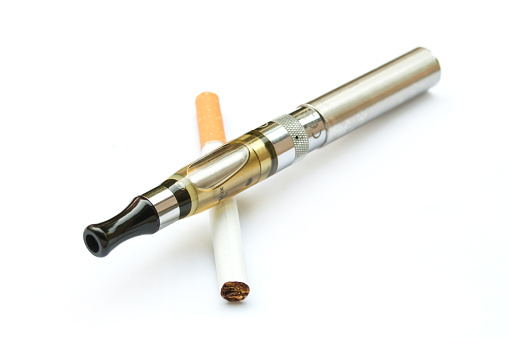Is using e-cigarettes a healthier alternative to traditional cigarettes?

Is using e-cigarettes a healthier alternative to traditional cigarettes?
E-cigarettes or also known as vape have become increasingly common and popular in many countries including Malaysia. While cigarette smokers may use ECs to help them stop smoking, and long-term EC users report that ECs helped them stop or reduce their smoking, the possibility that young people will become addicted to the nicotine in ECs raises serious safety concerns. Here are the things that you should know about e-cigarettes.

What are E-cigarettes and How does it work?
A device called an electronic cigarette (or “e-cigarette”) warms up liquid nicotine and flavoring so you can inhale it. Vapes, vape pens or sticks, e-hookahs, hookah sticks, mods, and personal vaporizers are just a few of the various variations of electronic cigarettes that exist (PVs). Additionally, they can all be referred to as electronic nicotine delivery devices (ENDS).
Most of the types of e-cigarettes have :
- A heating element for turning the liquid into breathable particles ( aerosol, commonly called “vapor”)
- A battery or control button (some are activated by sensors when you inhale)
- A mouthpiece to breath in the aerosol
- A power or control button ( some are activated by sensors when you inhale)
- A cartridge, tank or pod
When you vape, you use a small, portable device (such as an e-cigarette, a vape pen, or a mod) to inhale a flavor- and nicotine-containing mist (e-liquid). Vaping is comparable to smoking a cigarette, but instead of burning tobacco, it heats microscopic particles out of a liquid.
In order to breathe heated liquid into your lungs while vaping, a tiny piece of equipment is used. The liquid inside the e-cigarette, vape pen, or other vaping device is heated in order to produce an aerosol. This is not vaporized water. E-cigarette mist contains airborne nicotine, flavour, and other chemical particles. These specks are inhaled into your mouth through the mouthpiece, where they go to your throat and lungs.
What is the difference between vaping and smoking cigarettes?
The majority of people still believe that vaping and smoking are the same thing despite the obvious contrasts between the two ideas. While vaping derives from the root word “vapor,” smoking originates from the term “smoke.”
How the two substances are made makes the main distinction between smoke and vapor. Combustion is the process that causes a substance to release smoke (usually incomplete combustion). On the other hand, vaporization, or simply heating a liquid until it evaporates, causes a substance to produce a vapor.
Thus, the act of inhaling a cigarette puff and exhaling it can be described as smoking. Typically, the smoker inhales through the mouth and exhales through the mouth or nose, with a sizable portion of the puff traveling through the windpipe and into the lungs. When someone vapes, they exhale the vapor after taking a puff on a vaping device, sometimes referred to as an e-cigarette.

Is vaping worse than cigarettes?
Although it is frequently believed that vaping is safer than cigarette smoking, it nevertheless has negative health effects. Smoking and vaping both have an addictive nature and expose you to potentially harmful toxins. When you burn tobacco, the concentrations of several of these compounds are raised. As for now, no one has enough information about vaping’s potential long-term harm.
What does vaping do to your lungs?
The particles you inhale while vaping can cause inflammation (swelling) and irritation in your lungs. This can lead to lung damage like scarring and narrowing of the tubes that bring air in and out of your lungs. As more people use e-cigarettes, experts will learn more about how vaping affects the lungs. What is currently known is that vaping is linked to a number of respiratory diseases:
Vaping and popcorn lung
- Bronchiolitis obliterans (BO), a rare disease brought on by damage to the lungs’ tiny airways, is also known as “popcorn lung.” Workers at a popcorn plant began falling ill, which is how BO was first identified. The culprit was diacetyl, a food ingredient used in microwave popcorn to mimic the flavor of butter. To improve the flavor of flavored e-liquid, dialcetyl is routinely used. Diacetyl promotes inflammation and may result in popcorn lung, a permanent scarring of the tiniest branches of the airways, which makes breathing challenging. There is no long-lasting cure for popcorn lung. However, there are methods to address the signs and symptoms of BO, including: Coughing, Wheezing, Chest pain, shortness of breath
Vaping – related lipoid pneumonia
- Lipoid pneumonia, which is different from the typical type of pneumonia brought on by an infection, happens when fatty acids, which are the building blocks of fat, enter the lungs. Inhaling oily components found in e-liquid causes an inflammatory response in the lungs, which leads to lipoid pneumonia associated with vaping.
The following list of lipoid pneumonia symptoms are : Chronic cough, shortness of breath, coughing up blood or blood – tinged mucus.
Primary Spontaneous Pneumothorax (Collapsed Lung) after vaping
- Primary spontaneous pneumothorax, often known as a collapsed lung, occurs when the lung develops a hole through which oxygen can leak. Air blisters on the top of the lungs can rupture and cause microscopic tears as a result of an injury, such as a gunshot or knife wound.
- These blisters typically appear on tall, skinny individuals who experienced a period of rapid growth throughout adolescence. The top of the lungs may blister and create a weak spot as a result of the faster growth. These blisters normally don’t cause symptoms on their own. You are unaware of their presence until they break. A higher risk of popping these blisters, which could result in lung collapse, is linked to smoking and, more recently, vaping. Signs of a collapsed lung include : Sharp chest or shoulder pain, shortness of breath, difficulty breathing.

Isn’t vaping just water vapor?
No. Despite the name, vaping doesn’t make water vapor. It actually creates an aerosol (or mist) that contains small particles of nicotine, metal and other harmful substances.
What’s in e-liquid (e-juice)?
Vaping devices create the vapor you inhale using e-liquid, often known as e-juice or vape juice. It’s not only water in e-liquids. They often include:
- Flavoring. Each flavoring has its own set of ingredients.
- Nicotine, the addictive and harmful substance in cigarettes and other tobacco products.
- Propylene glycol and glycerin, used to create vapor.
E-liquids and flavorings sometimes have other ingredients, including:
- Chemicals that can cause cancer (carcinogens), like acetaldehyde and formaldehyde.
- Chemicals known to cause lung disease, such as acrolein, diacetyl and diethylene glycol.
- THC (tetrahydrocannabinol), the chemical in marijuana that gets you “high.”
- Vitamin E acetate, linked to lung injury caused by vaping (EVALI, see below).
- Heavy metals like nickel, tin, lead and cadmium.
- Tiny (ultrafine) particles that can get deep into your lungs.
What is the risk of vaping?
The dangers of vaping include lung and other organ damage, breathing problems, addiction and more. People tend to think of vaping as “safer” than smoking, but it’s not.
Problems vaping causes include:
- Respiratory problems: Vaping can damage the lungs and lead to breathing difficulties, bronchitis, and lung infections. The inhalation of the heated chemicals can irritate and damage the airways, leading to coughing, wheezing, and shortness of breath.
- Cardiovascular problems : Vaping can increase the risk of heart attacks, stroke, and high blood pressure. The chemicals in e-cigarettes can affect the cardiovascular system, leading to changes in heart rate and blood flow.
- Addiction : Vaping can be addictive, leading to a cycle of dependence on nicotine and the vaping device. The high levels of nicotine in e-cigarettes can cause cravings and withdrawal symptoms, making it difficult to quit.
- Birth defects : Pregnant women who vape risk exposing their fetus to harmful chemicals, potentially leading to birth defects. The chemicals in e – cigarette vapor can cross the placenta and affect the developing fetus, leading to health problems.
- Mouth and throat irritation : Vaping can cause mouth and throat irritation leading to soreness, dryness and redness. This can make it difficult to eat or talk and can increase th erisk of infections.
- Headaches : Vaping can cause headaches, as well as dizziness, lightheaddedness, and nausea. These symptoms may be due to the chemicals in e-cigarette vapor, or the inhalation of large amounts of nicotine.
- Eye irritation : Vaping can also cause eye irritation, leading to redness, itching, and tearing. This can be due to exposure to the chemicals in e-cigarette vapor, or to the high levels of nicotine in the blood.
- Skin irritation : Vaping can cause skin irritation, leading to redness, itching, and rashes. This can be due to the chemicals in e-cigarette vapor, or to the high levels of nicotine in the blood.
- Immune system suppression : Vaping can suppress the immune system, making it harder for the body to fight off infections and diseases. The chemicals in e-cigarette vapor can damage the immune system, leading to a weakened defense against illness and disease.

What are the side effects of vaping?
About 40% of daily e-cigarette users reported suffering typical vaping adverse effects, according to a 2021 study that was published in the International Journal of Environmental Research and Public Health. The most often reported side symptoms were coughing, dry mouth and throat, and headaches.
Other short-term side effects of vaping include:
- Shortness of breath.
- Eye irritation.
- Dry and irritated mouth and throat.
- Nausea.
What are the benefits of vaping?
You may have heard that vaping has health benefits or aids in quitting smoking. If they’ve already tried various techniques and failed to stop smoking, some people believe that vaping will help them succeed. Unfortunately, the benefits of vaping for quitting smoking may not be as good as they seem because you could become hooked on it. If you don’t already smoke, vaping is not beneficial.
The mist you breathe in while vaping still contains nicotine and other dangerous substances, despite what most people believe. Vaping is dangerous and can lead to lung ailments that are potentially fatal.
Can your lungs heal from vaping?
Yes. Yes, your lungs can recover once you stop vaping. Obviously, you need to give it some time. Generally speaking, you will discover that your sense of taste and smell recover in 2 or 3 days. Your bronchial tubes will start to open up in 5 to 7 days, making it simpler for you to breathe and causing you to feel more refreshed. Additionally, between the span of 3 and 9 months, your lung capacity will grow by at least 10%. After that, there will be nothing but positive effects on your health.
But others, like lung scarring, are permanent. Over time, constant irritation to your lungs can lead to health problems (like asthma and COPD) that won’t go away.

How can you quit vaping?
Quitting vaping is similar to quitting smoking, sticking to a diet or any other habit you want to change. It’s a process that won’t happen overnight, but you can make a plan to help you along the way:
- Make goals, even if it includes reducing vaping gradually.
- Set a quit date. Make sure it’s not too far away or at the same time as a stressful event.
- Talk to a healthcare provider, therapist or school counselor about quitting. They can help you make a plan that works for you and give you support in the process.
- Ask your provider, therapist or school counselor about free resources to help you quit, like online, texting and phone services or apps.
- Let friends and family know your plans for quitting. They can give you support and hold you accountable to stick to your plan.
- Make a list of reasons you want to quit vaping. Look at it or think of it throughout the process of quitting.
- Avoid temptations and triggers. Try to avoid situations where you normally vape or replace them with other activities.
- Get exercise. Not only does exercise distract you from the desire to vape, it also helps you feel good.
- Know that you’ll have cravings and some side effects, like headaches or anxiety. Nicotine gum, patches or other medications can help with cravings.
- Learn to relax with yoga, meditation and deep or rhythmic breathing.

Conclusion
From accessories to flavors, vaping can seem very appealing. Unfortunately, it’s not as harmless as it seems. We know nicotine and other ingredients in e-liquids can hurt your body and we still don’t know what long-term health problems vaping could cause. If you don’t vape, don’t start. If you need help quitting, know that you’re not alone. There are online resources, texting and phone services and apps that connect you with real people to help you on your journey to kick the habit.











